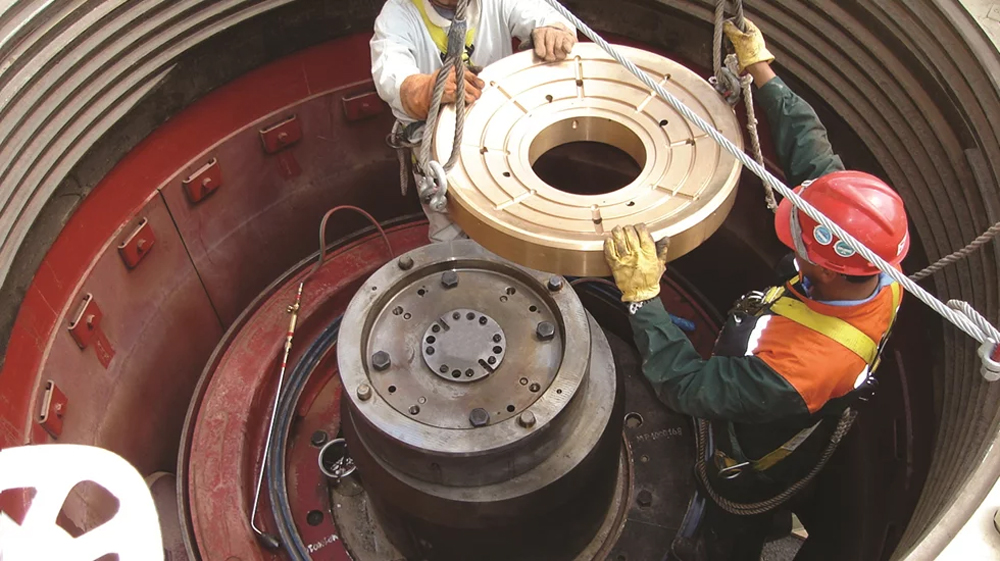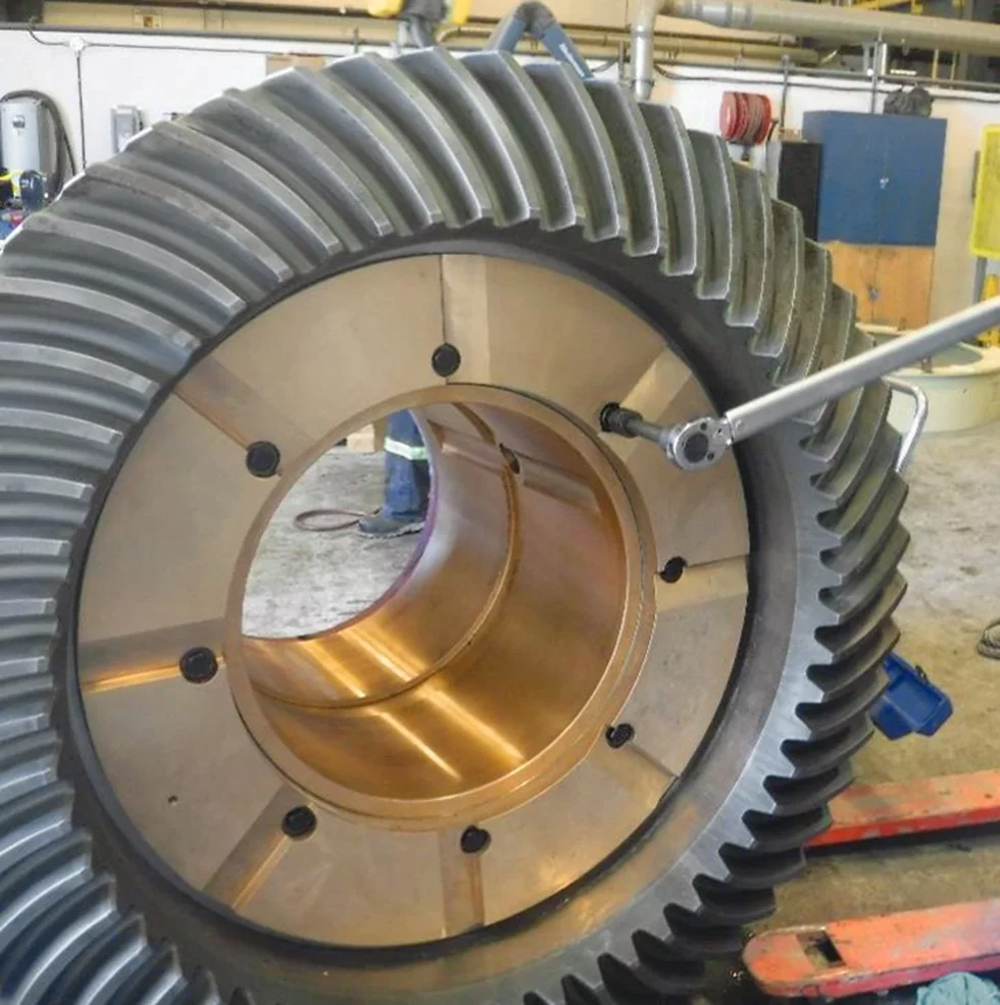Replacing crusher components – what you should consider
Many plants have to evaluate whether to do major component replacements in-house or take advantage of OEM service teams to complement their site personnel’s efforts. Baden Parker, Senior Manager, Global Field Services with Metso Outotec, shares his thoughts on what needs to be considered when dealing with these major service events.

When it comes to replacing major components for gyratory, cone and jaw crushers, finding the right personnel who are trained for these specialised tasks can be a challenge. Bottom shells, mainshafts or gears eventually need replacement or even an upgrade to take advantage of product improvements. Large and heavy parts often require specialised handling and installation procedures, as well as specialised tools to ensure safety.
When replacing an eccentric, a pitman, a pinion or any other major crusher component, many questions can come up. Has the site planned this type of work before, and does it have all the right tools? Are all the service steps perfectly understood to do the work safely and efficiently? Are there experienced personnel available to execute the part change-out? Does the site service team know what to look for to make sure the parts come together properly? Are new parts to be used or are the existing parts that are going to be re-used in good condition?

Using in-house expertise, OEM support or both
Many mine sites and plants try to tackle these types of crusher component change-outs with their in-house capabilities. However, even with sites that have strong maintenance teams, there are many challenges that may not be considered. Some sites may have to deal with high turnover in key service positions, leading to uncertainty in how to perform these major and non-routine maintenance tasks. Other plants need to service many models and brands of equipment and may not have the specialised knowledge that comes from performing complicated parts’ change-outs on a regular basis. There is also the constant struggle between production and maintenance aims and goals. When the pressure is on to increase production, there can be the temptation to shortcut maintenance times, which can lead to equipment problems or safety concerns that outweigh the time saved doing the actual work.
Having served at mine sites for 10 years, holding roles such as Shift Mechanical Fitter, Leading Hand, Supervisor, Senior Supervisor & Maintenance Planner before joining Metso Outotec as a crusher maintenance expert, has given me a broad view when it comes to service operations. I gained considerable knowledge on the life cycle of a site’s crushing assets and the maintenance required to ensure equipment reliability and, in turn, plant availability. I can say with confidence that if the on-site crews are well trained, many routine tasks can be handled safely and competently. However, a typical maintenance mentality that I observed (and personally held for some time) is ‘We can fix anything ourselves’ and that calling in the OEM was not needed, as we could work out the best ways of working ourselves. For many routine component replacements, this was indeed true enough.
However, over time I changed my view and realised that, in many cases, OEM support complemented a site team’s strengths and led to a far better result in terms of efficiently maintaining a site’s crushing equipment. I would like to share just a couple of examples that I have seen first-hand, relating to gyratory crusher component replacement work, that display how not pulling in needed know-how can be detrimental and potentially costly.
“Leveraging OEM know-how for major component replacement can pay dividends in terms of smoother change-outs and higher equipment availability due to less issues and rework caused by small missteps.”
BADEN PARKER, SENIOR MANAGER, GLOBAL FIELD SERVICES WITH METSO OUTOTEC
Issue 1
Gyratory Crusher – Spider bushing seals are damaged on installation or replacement. If the seals are damaged, it can result in excessive leaking of lubricant. This can lead to potential equipment damage and additional plant downtime, resulting in loss of production, negative environmental impact and increased costs associated with re-work and replacement parts.
How it can occur
A common practice adopted by some customers is installing the spider bushing into the spider before installing the spider onto the crusher, despite Metso Outotec manuals outlining that this is not the correct or recommended practice. Theoretically, this practice can be done, however, it is likely to damage the spider bushing seals when positioning over the main shaft due to misalignment.
Effect
Some customers are not prepared for a shutdown to address the issue immediately, due to the costs associated with loss of production. Instead, they convert the lubrication system over to grease in a temporary ad-hoc style, which can result in further issues down the road.
Best practice
With the knowledge of our certified Metso Outotec teams, combined with a drive for continuous improvement, the component replacement process for the service work is revised internally based on best practices. The practice within the Metso Outotec team is to install the spider bushing after the main shaft and spider are already installed. This doesn’t crucially increase the time to do the job and it helps the installer ensure the seals are not damaged upon installation.
Issue 2
Gyratory Crusher – Pinion or eccentric gear is damaged upon removal of pinion shaft assembly, potentially leading to costly component replacement, reduced equipment reliability and downtime.
How it can occur
Due to time constraints and the desire to bring the plant online sooner, some customers tend to remove their pinion shaft assemblies without first removing the MPS and eccentric assembly. Again, this can be done, in theory, if proper care is taken. However, it can be quite challenging to do in practice. The eccentric and pinion gear are a spiral bevel type of gear, which means you would need to rotate the pinion as you try to withdraw the pinion shaft assembly from the housing. On multiple occasions, we have observed the pinion gear binding up against the eccentric gear when attempting to do it this way. When this happens, the application of more force is used to free up the gear, which can, in the process, cause damage to the gear teeth.
Effect
As the pinion shaft and eccentric assembly form part of the crusher drive train, any damage to these sensitive components can have a catastrophic effect on equipment reliability and functionality.
Best practice
Metso Outotec recommends removing the MPS and eccentric assembly prior to removing the pinion shaft assembly. This ensures no damage is incurred during the removal or installation process. Our team of experts have done this process many times and have optimised the procedure to ensure it is accomplished safely, in time and without damage to components. Taking a risk to save 8-12 hours of downtime is certainly not worth the cost, especially if things go wrong.

Combining approaches for highest crusher uptime
Having strong in-house site teams to service crushing and screening equipment can bring many benefits and cost savings to a plant. However, complementing their efforts by having an OEM service team either execute or supervise larger, more complicated, or less often performed component replacements should always be considered and can bring the best of both worlds. Leveraging OEM know-how for major component replacement can pay dividends in terms of smoother change-outs and higher equipment availability due to less issues and rework caused by small missteps.
By utilising Metso Outotec crusher component replacement services, sites can benefit from the OEM team’s experience in scheduling and staging pre-outage activities, as well as executing the work quickly to significantly reduce downtime. It also brings the advantage of having one point of responsibility for the entire maintenance event. In some cases, OEM warranties can often be extended when Metso Outotec crews perform the installation of major parts. With access to global knowledge centres, trouble shooting and adjustments can often be done on the spot by our on-site crews, bringing further uptime benefits.













